Deep Vein Thrombosis Prophylaxis in Patients
VerifiedAdded on 2020/05/08
|18
|5476
|44
AI Summary
The assignment delves into the topic of deep vein thrombosis (DVT) prophylaxis in hospitalized patients. It examines different prophylactic measures, such as elastic compression stockings, pneumatic compression devices, and pharmacological agents like heparin or warfarin. The provided references encompass clinical practice guidelines, systematic reviews, and research articles that shed light on the effectiveness and safety of various DVT prevention methods in diverse patient populations undergoing surgery, trauma, or neurological interventions.
Contribute Materials
Your contribution can guide someone’s learning journey. Share your
documents today.
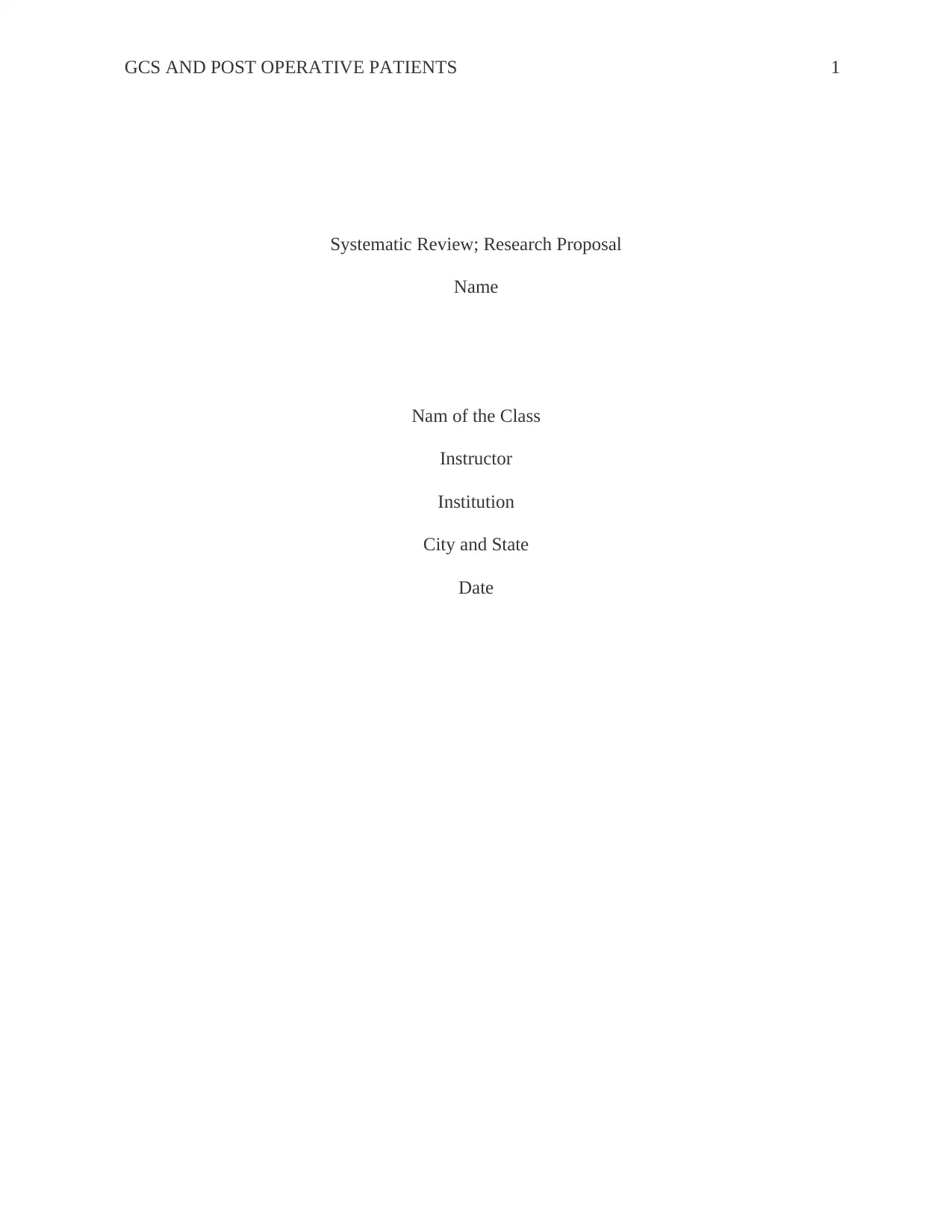
GCS AND POST OPERATIVE PATIENTS 1
Systematic Review; Research Proposal
Name
Nam of the Class
Instructor
Institution
City and State
Date
Systematic Review; Research Proposal
Name
Nam of the Class
Instructor
Institution
City and State
Date
Secure Best Marks with AI Grader
Need help grading? Try our AI Grader for instant feedback on your assignments.
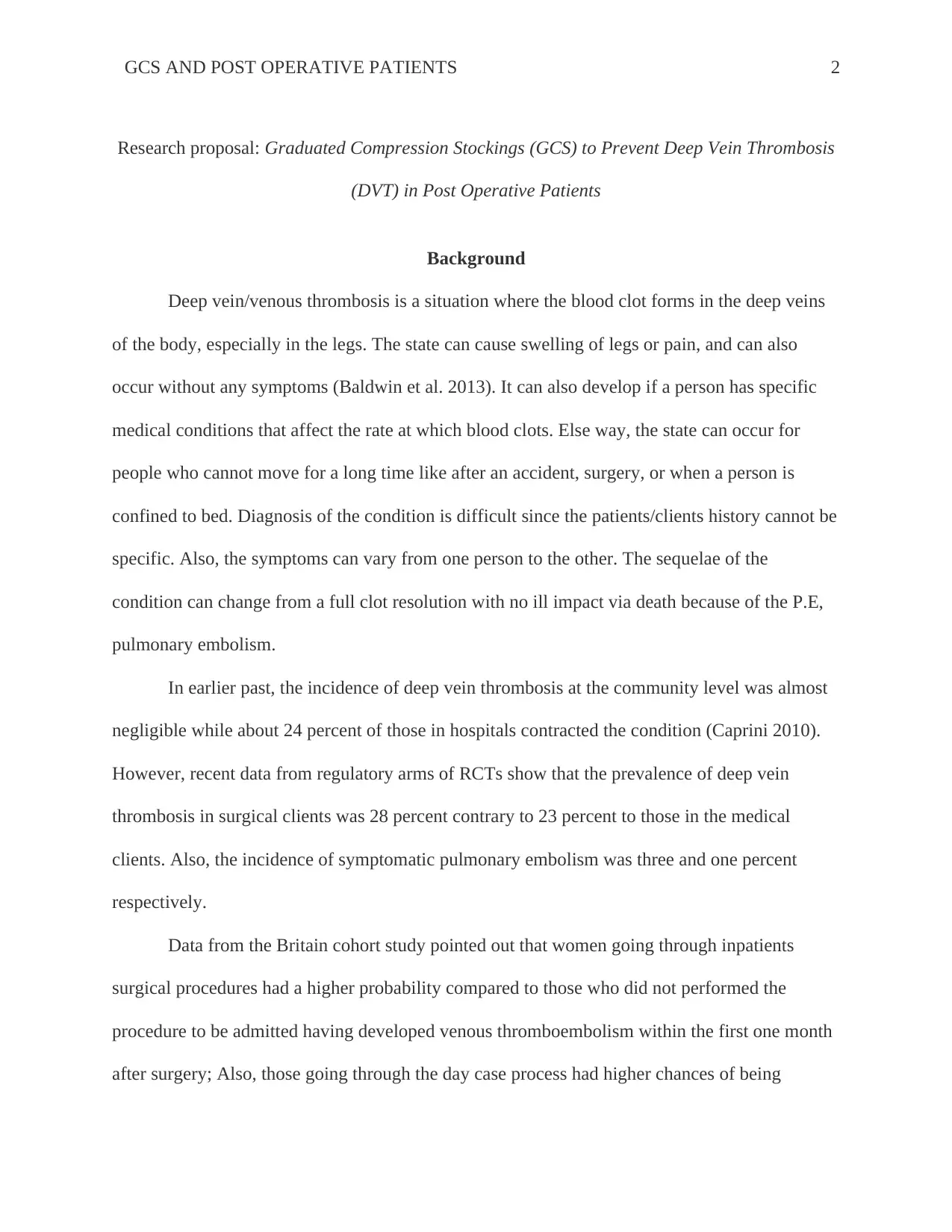
GCS AND POST OPERATIVE PATIENTS 2
Research proposal: Graduated Compression Stockings (GCS) to Prevent Deep Vein Thrombosis
(DVT) in Post Operative Patients
Background
Deep vein/venous thrombosis is a situation where the blood clot forms in the deep veins
of the body, especially in the legs. The state can cause swelling of legs or pain, and can also
occur without any symptoms (Baldwin et al. 2013). It can also develop if a person has specific
medical conditions that affect the rate at which blood clots. Else way, the state can occur for
people who cannot move for a long time like after an accident, surgery, or when a person is
confined to bed. Diagnosis of the condition is difficult since the patients/clients history cannot be
specific. Also, the symptoms can vary from one person to the other. The sequelae of the
condition can change from a full clot resolution with no ill impact via death because of the P.E,
pulmonary embolism.
In earlier past, the incidence of deep vein thrombosis at the community level was almost
negligible while about 24 percent of those in hospitals contracted the condition (Caprini 2010).
However, recent data from regulatory arms of RCTs show that the prevalence of deep vein
thrombosis in surgical clients was 28 percent contrary to 23 percent to those in the medical
clients. Also, the incidence of symptomatic pulmonary embolism was three and one percent
respectively.
Data from the Britain cohort study pointed out that women going through inpatients
surgical procedures had a higher probability compared to those who did not performed the
procedure to be admitted having developed venous thromboembolism within the first one month
after surgery; Also, those going through the day case process had higher chances of being
Research proposal: Graduated Compression Stockings (GCS) to Prevent Deep Vein Thrombosis
(DVT) in Post Operative Patients
Background
Deep vein/venous thrombosis is a situation where the blood clot forms in the deep veins
of the body, especially in the legs. The state can cause swelling of legs or pain, and can also
occur without any symptoms (Baldwin et al. 2013). It can also develop if a person has specific
medical conditions that affect the rate at which blood clots. Else way, the state can occur for
people who cannot move for a long time like after an accident, surgery, or when a person is
confined to bed. Diagnosis of the condition is difficult since the patients/clients history cannot be
specific. Also, the symptoms can vary from one person to the other. The sequelae of the
condition can change from a full clot resolution with no ill impact via death because of the P.E,
pulmonary embolism.
In earlier past, the incidence of deep vein thrombosis at the community level was almost
negligible while about 24 percent of those in hospitals contracted the condition (Caprini 2010).
However, recent data from regulatory arms of RCTs show that the prevalence of deep vein
thrombosis in surgical clients was 28 percent contrary to 23 percent to those in the medical
clients. Also, the incidence of symptomatic pulmonary embolism was three and one percent
respectively.
Data from the Britain cohort study pointed out that women going through inpatients
surgical procedures had a higher probability compared to those who did not performed the
procedure to be admitted having developed venous thromboembolism within the first one month
after surgery; Also, those going through the day case process had higher chances of being

GCS AND POST OPERATIVE PATIENTS 3
admitted. According to CLOTS (2013), the risks which were left increased seven to twelve
weeks after surgery, where the pattern of risk was the same to that of pulmonary embolism and
deep vein thrombosis. Ideally, the risks varied significantly due to surgery type. However it is
approximated that over 20, 000 people in England are at risk of dying each year due to
potentially preventable venous thromboembolism developed while in healthcare centres.
Surgical patients are however at high risk of venous thromboembolism if they can
achieve the following guidelines. First, is the surgical procedure having a complete anaesthetic
as well as a surgical period of more than 1.5 hours or 1 hour if the process involves the lower
limb or the pelvis (De et al. 2010). Second is acute surgical admission with intra-abdominal
condition or inflammatory, obesity, dehydration, critical care admission, active cancer/ cancer
treatment, and known thrombophilias to mention just a few.
As of late, there have been shifts in some of the factors that influence the risk of post-
surgery deep vein thrombosis. De et al. (2010) postulates that, surgical practices have changed to
the extent at which the time of general anaesthetic becomes short; the operation is done using a
local anaesthetic. However, the time at which the client stays in the healthcare unit is very short
with lots of procedures being done on a daily basis. Therefore, patients are mobilised
immediately while those discharged home get help from physiotherapists in the community.
Moreover, modern anticoagulants like rivaroxaban can be used for an extended period providing
long protection to clients. For example, in 2010, the health department developed a risk
assessment for VTT or venous thromboembolism tool for use in people in healthcare units
(CLOTS 2013). It’s also the NICE quality standards that every person on admission to healthcare
unit gets an assessment of the personal risk of venous thromboembolism as well as bleeding
using clinical risk evaluation criterion which is described in the tool mentioned above.
admitted. According to CLOTS (2013), the risks which were left increased seven to twelve
weeks after surgery, where the pattern of risk was the same to that of pulmonary embolism and
deep vein thrombosis. Ideally, the risks varied significantly due to surgery type. However it is
approximated that over 20, 000 people in England are at risk of dying each year due to
potentially preventable venous thromboembolism developed while in healthcare centres.
Surgical patients are however at high risk of venous thromboembolism if they can
achieve the following guidelines. First, is the surgical procedure having a complete anaesthetic
as well as a surgical period of more than 1.5 hours or 1 hour if the process involves the lower
limb or the pelvis (De et al. 2010). Second is acute surgical admission with intra-abdominal
condition or inflammatory, obesity, dehydration, critical care admission, active cancer/ cancer
treatment, and known thrombophilias to mention just a few.
As of late, there have been shifts in some of the factors that influence the risk of post-
surgery deep vein thrombosis. De et al. (2010) postulates that, surgical practices have changed to
the extent at which the time of general anaesthetic becomes short; the operation is done using a
local anaesthetic. However, the time at which the client stays in the healthcare unit is very short
with lots of procedures being done on a daily basis. Therefore, patients are mobilised
immediately while those discharged home get help from physiotherapists in the community.
Moreover, modern anticoagulants like rivaroxaban can be used for an extended period providing
long protection to clients. For example, in 2010, the health department developed a risk
assessment for VTT or venous thromboembolism tool for use in people in healthcare units
(CLOTS 2013). It’s also the NICE quality standards that every person on admission to healthcare
unit gets an assessment of the personal risk of venous thromboembolism as well as bleeding
using clinical risk evaluation criterion which is described in the tool mentioned above.
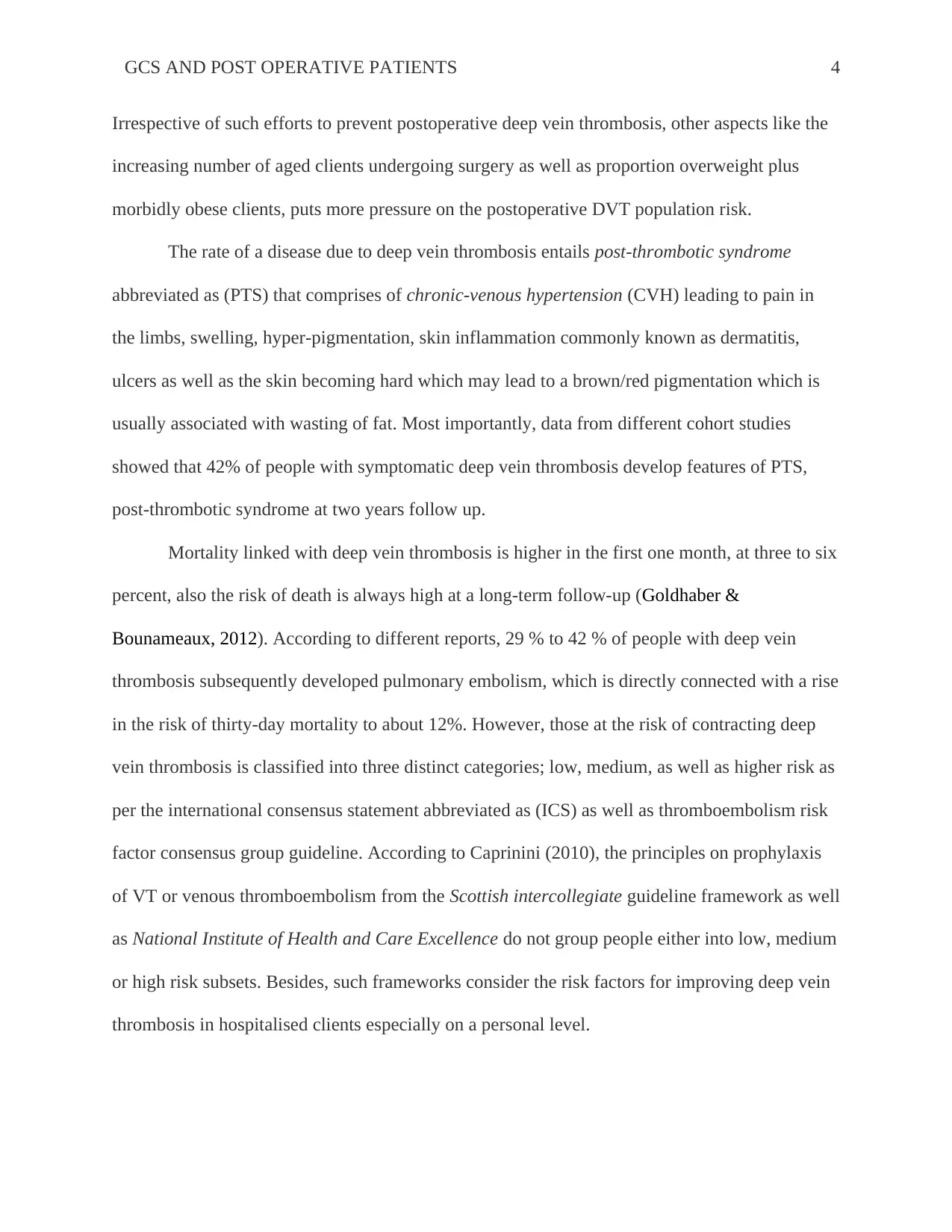
GCS AND POST OPERATIVE PATIENTS 4
Irrespective of such efforts to prevent postoperative deep vein thrombosis, other aspects like the
increasing number of aged clients undergoing surgery as well as proportion overweight plus
morbidly obese clients, puts more pressure on the postoperative DVT population risk.
The rate of a disease due to deep vein thrombosis entails post-thrombotic syndrome
abbreviated as (PTS) that comprises of chronic-venous hypertension (CVH) leading to pain in
the limbs, swelling, hyper-pigmentation, skin inflammation commonly known as dermatitis,
ulcers as well as the skin becoming hard which may lead to a brown/red pigmentation which is
usually associated with wasting of fat. Most importantly, data from different cohort studies
showed that 42% of people with symptomatic deep vein thrombosis develop features of PTS,
post-thrombotic syndrome at two years follow up.
Mortality linked with deep vein thrombosis is higher in the first one month, at three to six
percent, also the risk of death is always high at a long-term follow-up (Goldhaber &
Bounameaux, 2012). According to different reports, 29 % to 42 % of people with deep vein
thrombosis subsequently developed pulmonary embolism, which is directly connected with a rise
in the risk of thirty-day mortality to about 12%. However, those at the risk of contracting deep
vein thrombosis is classified into three distinct categories; low, medium, as well as higher risk as
per the international consensus statement abbreviated as (ICS) as well as thromboembolism risk
factor consensus group guideline. According to Caprinini (2010), the principles on prophylaxis
of VT or venous thromboembolism from the Scottish intercollegiate guideline framework as well
as National Institute of Health and Care Excellence do not group people either into low, medium
or high risk subsets. Besides, such frameworks consider the risk factors for improving deep vein
thrombosis in hospitalised clients especially on a personal level.
Irrespective of such efforts to prevent postoperative deep vein thrombosis, other aspects like the
increasing number of aged clients undergoing surgery as well as proportion overweight plus
morbidly obese clients, puts more pressure on the postoperative DVT population risk.
The rate of a disease due to deep vein thrombosis entails post-thrombotic syndrome
abbreviated as (PTS) that comprises of chronic-venous hypertension (CVH) leading to pain in
the limbs, swelling, hyper-pigmentation, skin inflammation commonly known as dermatitis,
ulcers as well as the skin becoming hard which may lead to a brown/red pigmentation which is
usually associated with wasting of fat. Most importantly, data from different cohort studies
showed that 42% of people with symptomatic deep vein thrombosis develop features of PTS,
post-thrombotic syndrome at two years follow up.
Mortality linked with deep vein thrombosis is higher in the first one month, at three to six
percent, also the risk of death is always high at a long-term follow-up (Goldhaber &
Bounameaux, 2012). According to different reports, 29 % to 42 % of people with deep vein
thrombosis subsequently developed pulmonary embolism, which is directly connected with a rise
in the risk of thirty-day mortality to about 12%. However, those at the risk of contracting deep
vein thrombosis is classified into three distinct categories; low, medium, as well as higher risk as
per the international consensus statement abbreviated as (ICS) as well as thromboembolism risk
factor consensus group guideline. According to Caprinini (2010), the principles on prophylaxis
of VT or venous thromboembolism from the Scottish intercollegiate guideline framework as well
as National Institute of Health and Care Excellence do not group people either into low, medium
or high risk subsets. Besides, such frameworks consider the risk factors for improving deep vein
thrombosis in hospitalised clients especially on a personal level.
Secure Best Marks with AI Grader
Need help grading? Try our AI Grader for instant feedback on your assignments.
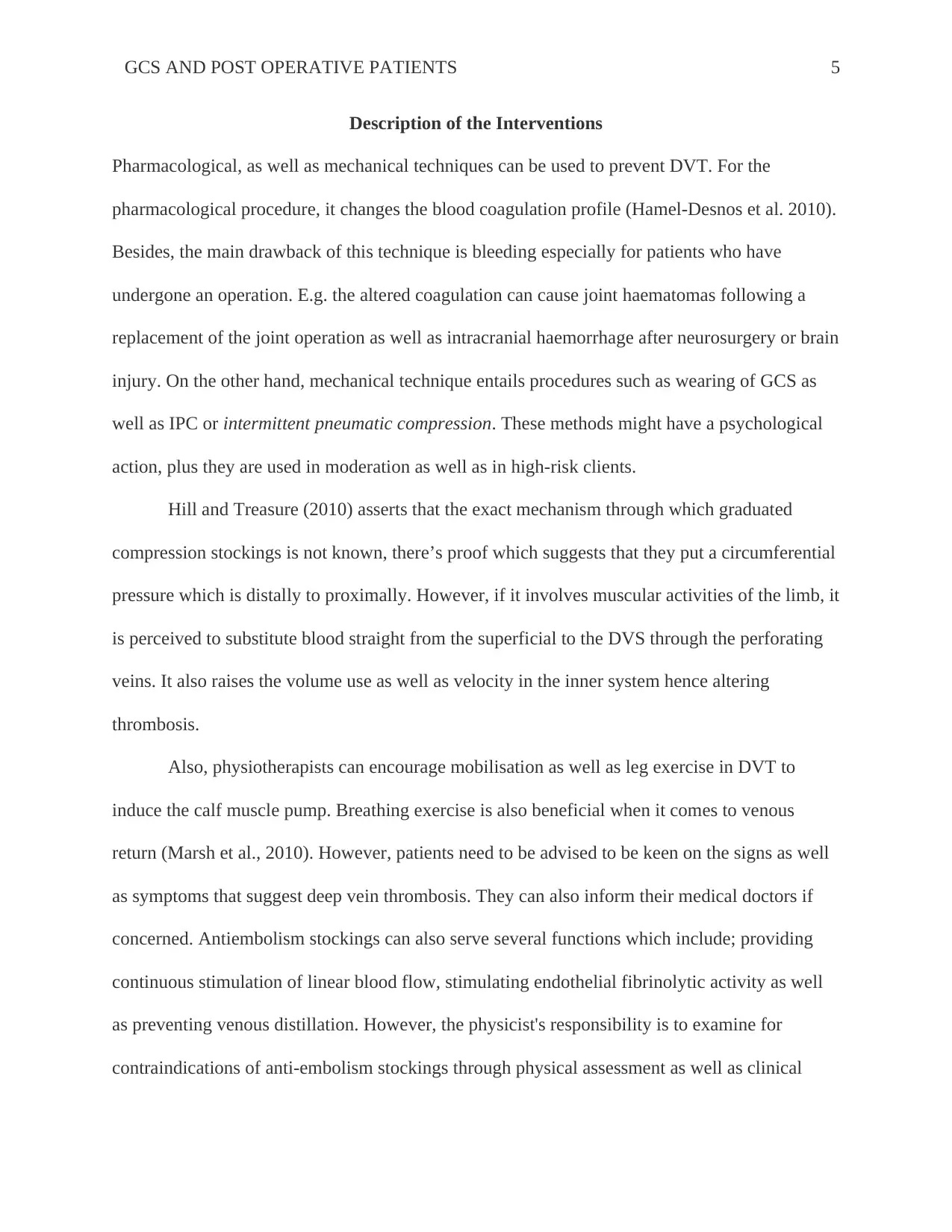
GCS AND POST OPERATIVE PATIENTS 5
Description of the Interventions
Pharmacological, as well as mechanical techniques can be used to prevent DVT. For the
pharmacological procedure, it changes the blood coagulation profile (Hamel-Desnos et al. 2010).
Besides, the main drawback of this technique is bleeding especially for patients who have
undergone an operation. E.g. the altered coagulation can cause joint haematomas following a
replacement of the joint operation as well as intracranial haemorrhage after neurosurgery or brain
injury. On the other hand, mechanical technique entails procedures such as wearing of GCS as
well as IPC or intermittent pneumatic compression. These methods might have a psychological
action, plus they are used in moderation as well as in high-risk clients.
Hill and Treasure (2010) asserts that the exact mechanism through which graduated
compression stockings is not known, there’s proof which suggests that they put a circumferential
pressure which is distally to proximally. However, if it involves muscular activities of the limb, it
is perceived to substitute blood straight from the superficial to the DVS through the perforating
veins. It also raises the volume use as well as velocity in the inner system hence altering
thrombosis.
Also, physiotherapists can encourage mobilisation as well as leg exercise in DVT to
induce the calf muscle pump. Breathing exercise is also beneficial when it comes to venous
return (Marsh et al., 2010). However, patients need to be advised to be keen on the signs as well
as symptoms that suggest deep vein thrombosis. They can also inform their medical doctors if
concerned. Antiembolism stockings can also serve several functions which include; providing
continuous stimulation of linear blood flow, stimulating endothelial fibrinolytic activity as well
as preventing venous distillation. However, the physicist's responsibility is to examine for
contraindications of anti-embolism stockings through physical assessment as well as clinical
Description of the Interventions
Pharmacological, as well as mechanical techniques can be used to prevent DVT. For the
pharmacological procedure, it changes the blood coagulation profile (Hamel-Desnos et al. 2010).
Besides, the main drawback of this technique is bleeding especially for patients who have
undergone an operation. E.g. the altered coagulation can cause joint haematomas following a
replacement of the joint operation as well as intracranial haemorrhage after neurosurgery or brain
injury. On the other hand, mechanical technique entails procedures such as wearing of GCS as
well as IPC or intermittent pneumatic compression. These methods might have a psychological
action, plus they are used in moderation as well as in high-risk clients.
Hill and Treasure (2010) asserts that the exact mechanism through which graduated
compression stockings is not known, there’s proof which suggests that they put a circumferential
pressure which is distally to proximally. However, if it involves muscular activities of the limb, it
is perceived to substitute blood straight from the superficial to the DVS through the perforating
veins. It also raises the volume use as well as velocity in the inner system hence altering
thrombosis.
Also, physiotherapists can encourage mobilisation as well as leg exercise in DVT to
induce the calf muscle pump. Breathing exercise is also beneficial when it comes to venous
return (Marsh et al., 2010). However, patients need to be advised to be keen on the signs as well
as symptoms that suggest deep vein thrombosis. They can also inform their medical doctors if
concerned. Antiembolism stockings can also serve several functions which include; providing
continuous stimulation of linear blood flow, stimulating endothelial fibrinolytic activity as well
as preventing venous distillation. However, the physicist's responsibility is to examine for
contraindications of anti-embolism stockings through physical assessment as well as clinical
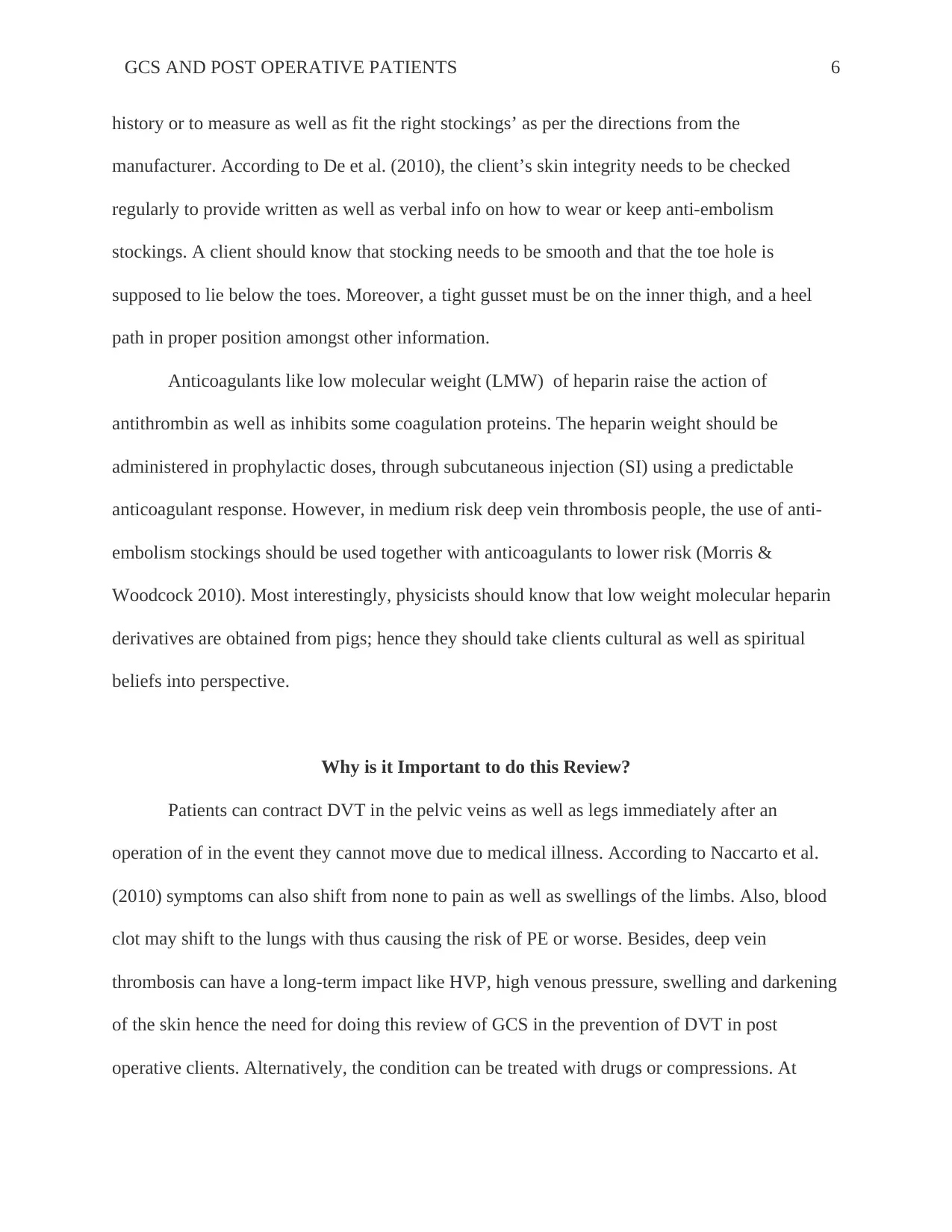
GCS AND POST OPERATIVE PATIENTS 6
history or to measure as well as fit the right stockings’ as per the directions from the
manufacturer. According to De et al. (2010), the client’s skin integrity needs to be checked
regularly to provide written as well as verbal info on how to wear or keep anti-embolism
stockings. A client should know that stocking needs to be smooth and that the toe hole is
supposed to lie below the toes. Moreover, a tight gusset must be on the inner thigh, and a heel
path in proper position amongst other information.
Anticoagulants like low molecular weight (LMW) of heparin raise the action of
antithrombin as well as inhibits some coagulation proteins. The heparin weight should be
administered in prophylactic doses, through subcutaneous injection (SI) using a predictable
anticoagulant response. However, in medium risk deep vein thrombosis people, the use of anti-
embolism stockings should be used together with anticoagulants to lower risk (Morris &
Woodcock 2010). Most interestingly, physicists should know that low weight molecular heparin
derivatives are obtained from pigs; hence they should take clients cultural as well as spiritual
beliefs into perspective.
Why is it Important to do this Review?
Patients can contract DVT in the pelvic veins as well as legs immediately after an
operation of in the event they cannot move due to medical illness. According to Naccarto et al.
(2010) symptoms can also shift from none to pain as well as swellings of the limbs. Also, blood
clot may shift to the lungs with thus causing the risk of PE or worse. Besides, deep vein
thrombosis can have a long-term impact like HVP, high venous pressure, swelling and darkening
of the skin hence the need for doing this review of GCS in the prevention of DVT in post
operative clients. Alternatively, the condition can be treated with drugs or compressions. At
history or to measure as well as fit the right stockings’ as per the directions from the
manufacturer. According to De et al. (2010), the client’s skin integrity needs to be checked
regularly to provide written as well as verbal info on how to wear or keep anti-embolism
stockings. A client should know that stocking needs to be smooth and that the toe hole is
supposed to lie below the toes. Moreover, a tight gusset must be on the inner thigh, and a heel
path in proper position amongst other information.
Anticoagulants like low molecular weight (LMW) of heparin raise the action of
antithrombin as well as inhibits some coagulation proteins. The heparin weight should be
administered in prophylactic doses, through subcutaneous injection (SI) using a predictable
anticoagulant response. However, in medium risk deep vein thrombosis people, the use of anti-
embolism stockings should be used together with anticoagulants to lower risk (Morris &
Woodcock 2010). Most interestingly, physicists should know that low weight molecular heparin
derivatives are obtained from pigs; hence they should take clients cultural as well as spiritual
beliefs into perspective.
Why is it Important to do this Review?
Patients can contract DVT in the pelvic veins as well as legs immediately after an
operation of in the event they cannot move due to medical illness. According to Naccarto et al.
(2010) symptoms can also shift from none to pain as well as swellings of the limbs. Also, blood
clot may shift to the lungs with thus causing the risk of PE or worse. Besides, deep vein
thrombosis can have a long-term impact like HVP, high venous pressure, swelling and darkening
of the skin hence the need for doing this review of GCS in the prevention of DVT in post
operative clients. Alternatively, the condition can be treated with drugs or compressions. At
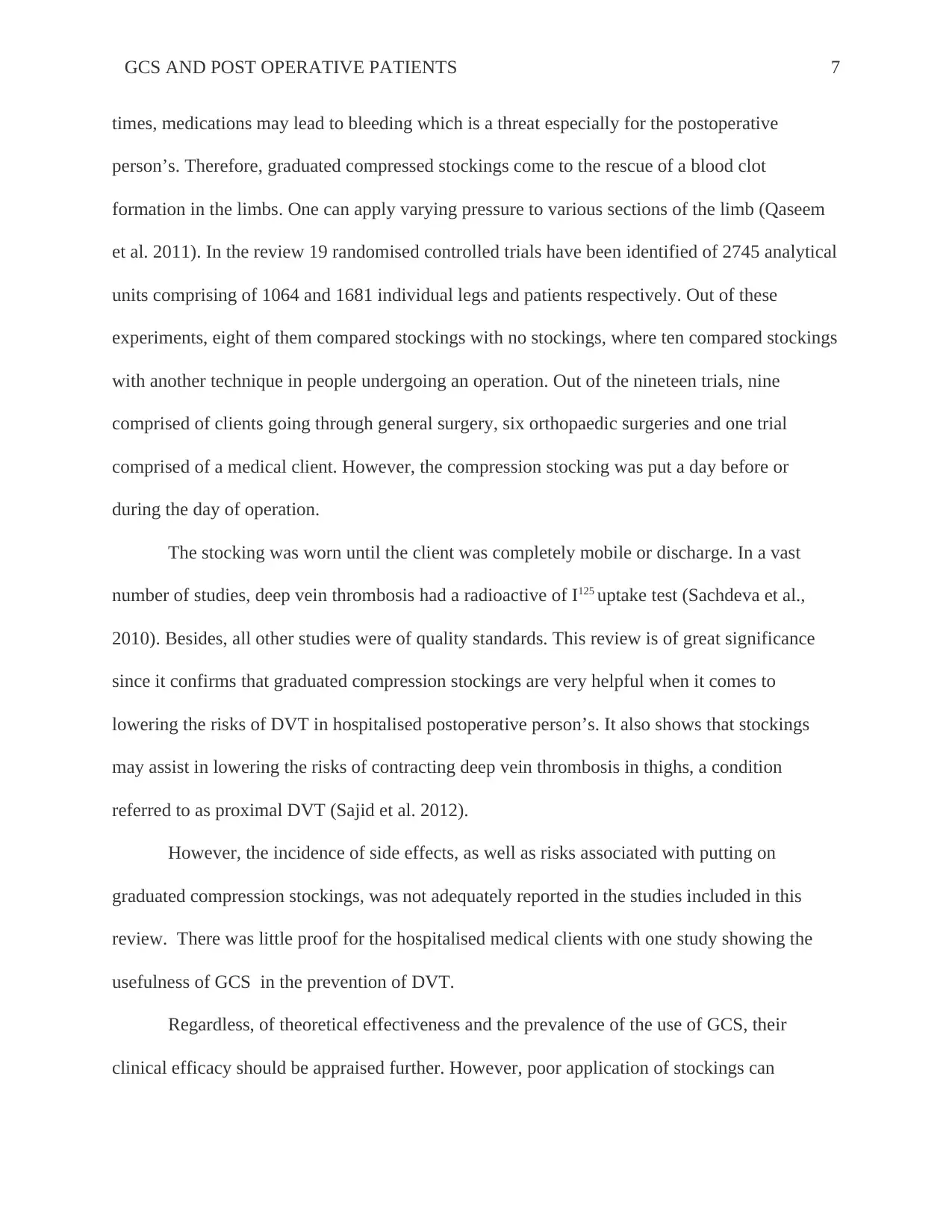
GCS AND POST OPERATIVE PATIENTS 7
times, medications may lead to bleeding which is a threat especially for the postoperative
person’s. Therefore, graduated compressed stockings come to the rescue of a blood clot
formation in the limbs. One can apply varying pressure to various sections of the limb (Qaseem
et al. 2011). In the review 19 randomised controlled trials have been identified of 2745 analytical
units comprising of 1064 and 1681 individual legs and patients respectively. Out of these
experiments, eight of them compared stockings with no stockings, where ten compared stockings
with another technique in people undergoing an operation. Out of the nineteen trials, nine
comprised of clients going through general surgery, six orthopaedic surgeries and one trial
comprised of a medical client. However, the compression stocking was put a day before or
during the day of operation.
The stocking was worn until the client was completely mobile or discharge. In a vast
number of studies, deep vein thrombosis had a radioactive of I125 uptake test (Sachdeva et al.,
2010). Besides, all other studies were of quality standards. This review is of great significance
since it confirms that graduated compression stockings are very helpful when it comes to
lowering the risks of DVT in hospitalised postoperative person’s. It also shows that stockings
may assist in lowering the risks of contracting deep vein thrombosis in thighs, a condition
referred to as proximal DVT (Sajid et al. 2012).
However, the incidence of side effects, as well as risks associated with putting on
graduated compression stockings, was not adequately reported in the studies included in this
review. There was little proof for the hospitalised medical clients with one study showing the
usefulness of GCS in the prevention of DVT.
Regardless, of theoretical effectiveness and the prevalence of the use of GCS, their
clinical efficacy should be appraised further. However, poor application of stockings can
times, medications may lead to bleeding which is a threat especially for the postoperative
person’s. Therefore, graduated compressed stockings come to the rescue of a blood clot
formation in the limbs. One can apply varying pressure to various sections of the limb (Qaseem
et al. 2011). In the review 19 randomised controlled trials have been identified of 2745 analytical
units comprising of 1064 and 1681 individual legs and patients respectively. Out of these
experiments, eight of them compared stockings with no stockings, where ten compared stockings
with another technique in people undergoing an operation. Out of the nineteen trials, nine
comprised of clients going through general surgery, six orthopaedic surgeries and one trial
comprised of a medical client. However, the compression stocking was put a day before or
during the day of operation.
The stocking was worn until the client was completely mobile or discharge. In a vast
number of studies, deep vein thrombosis had a radioactive of I125 uptake test (Sachdeva et al.,
2010). Besides, all other studies were of quality standards. This review is of great significance
since it confirms that graduated compression stockings are very helpful when it comes to
lowering the risks of DVT in hospitalised postoperative person’s. It also shows that stockings
may assist in lowering the risks of contracting deep vein thrombosis in thighs, a condition
referred to as proximal DVT (Sajid et al. 2012).
However, the incidence of side effects, as well as risks associated with putting on
graduated compression stockings, was not adequately reported in the studies included in this
review. There was little proof for the hospitalised medical clients with one study showing the
usefulness of GCS in the prevention of DVT.
Regardless, of theoretical effectiveness and the prevalence of the use of GCS, their
clinical efficacy should be appraised further. However, poor application of stockings can
Paraphrase This Document
Need a fresh take? Get an instant paraphrase of this document with our AI Paraphraser

GCS AND POST OPERATIVE PATIENTS 8
potentially lead to problems such as arterial ischemia, oedema of the legs as well as deep vein
thrombosis (Salmaggi et al., 2013). Stockings are also contraindicated for medical purposes.
However, the degree at which a leg profile of a client limits its usefulness has not yet been
addressed. Moreover, a recommendation concerning the proper length of stockings that is thigh
length and knee measurement is not a subject of this proposal review.
Objectives
The main aim of this proposal review is to show the usefulness as well as the safety of
GCS in the prevention of DVT of people hospitalised in different groups. Throughout the
proposal review, the following hypothesis was tested; stockings are not necessary for low-risk
clients; side effects are linked with the use of GCS; GCS are very much useful when it comes to
the prevention of DVT in hospitalised people apart from those with paralysis. Lastly, is that in
every moderate risk client GCS alone is not enough for deep vein thrombosis prophylaxis, unless
for clients where the stockings are contraindicated.
Methods:
1. Types of Studies
A review by Sajid and co-authors (2012) had three randomised control trials that
compared the efficiency of knee and thigh length in hospitalised surgical clients. No statistical
significant difference was found in regard to the clinical efficacy of the stocking measures about
lowering the incidence of the condition, deep vein thrombosis. Besides, there was substantial
heterogeneity in the trials plus significant methodological restrictions. Sajid et al. then concluded
that there was inadequate standard proof to investigate if knee or thigh length stocking would
potentially lead to problems such as arterial ischemia, oedema of the legs as well as deep vein
thrombosis (Salmaggi et al., 2013). Stockings are also contraindicated for medical purposes.
However, the degree at which a leg profile of a client limits its usefulness has not yet been
addressed. Moreover, a recommendation concerning the proper length of stockings that is thigh
length and knee measurement is not a subject of this proposal review.
Objectives
The main aim of this proposal review is to show the usefulness as well as the safety of
GCS in the prevention of DVT of people hospitalised in different groups. Throughout the
proposal review, the following hypothesis was tested; stockings are not necessary for low-risk
clients; side effects are linked with the use of GCS; GCS are very much useful when it comes to
the prevention of DVT in hospitalised people apart from those with paralysis. Lastly, is that in
every moderate risk client GCS alone is not enough for deep vein thrombosis prophylaxis, unless
for clients where the stockings are contraindicated.
Methods:
1. Types of Studies
A review by Sajid and co-authors (2012) had three randomised control trials that
compared the efficiency of knee and thigh length in hospitalised surgical clients. No statistical
significant difference was found in regard to the clinical efficacy of the stocking measures about
lowering the incidence of the condition, deep vein thrombosis. Besides, there was substantial
heterogeneity in the trials plus significant methodological restrictions. Sajid et al. then concluded
that there was inadequate standard proof to investigate if knee or thigh length stocking would

GCS AND POST OPERATIVE PATIENTS 9
vary in their effectiveness when it comes to lowering the prevalence of deep vein thrombosis in
hospitalised persons. However, the authors proposed for a more substantial multicentre
randomised control trial to be done to address the problem. In another review by Sachdeva and
co-authors (2010), they had 18 randomised control trials that compared the usefulness of
graduated compressed stockings, with or without another technique of deep vein thrombosis
prophylaxis without stockings in hospitalised people.
However, the prevalence of the condition, DVT was too way lower in the stockings and
other prophylactic technique group compared to another prophylactic alone group. Henceforth,
the reviewers concluded that stockings are very useful when it comes to reducing the risks of
deep vein thrombosis in postoperative people. Besides, the entire randomised control trials used
thin length stockings, and the authors recommended a randomised control trial comparing knee
as well as thigh length GCS.
Ideally, only the RCT that used compression stockings for DVT prophylaxis would be
included in this review. Moreover, the moment the allocations of concealments were enough and
the cover-ups were not used, then the studies would not be included (Salmaggi et al., 2013).
The above-mentioned reviews by Sajid and Sachdeva with their co authors did not answer the
research question. However, a study by Sajid included only three randomised control trial but did
not seek indirect proof. Also, the study by Sachdeva and his associates did not also limit the
inclusion aspect to postoperative clients or even compare the usefulness of knee and thigh length
stockings. Above all, the measurement of stocking in others studies remained unclear.
vary in their effectiveness when it comes to lowering the prevalence of deep vein thrombosis in
hospitalised persons. However, the authors proposed for a more substantial multicentre
randomised control trial to be done to address the problem. In another review by Sachdeva and
co-authors (2010), they had 18 randomised control trials that compared the usefulness of
graduated compressed stockings, with or without another technique of deep vein thrombosis
prophylaxis without stockings in hospitalised people.
However, the prevalence of the condition, DVT was too way lower in the stockings and
other prophylactic technique group compared to another prophylactic alone group. Henceforth,
the reviewers concluded that stockings are very useful when it comes to reducing the risks of
deep vein thrombosis in postoperative people. Besides, the entire randomised control trials used
thin length stockings, and the authors recommended a randomised control trial comparing knee
as well as thigh length GCS.
Ideally, only the RCT that used compression stockings for DVT prophylaxis would be
included in this review. Moreover, the moment the allocations of concealments were enough and
the cover-ups were not used, then the studies would not be included (Salmaggi et al., 2013).
The above-mentioned reviews by Sajid and Sachdeva with their co authors did not answer the
research question. However, a study by Sajid included only three randomised control trial but did
not seek indirect proof. Also, the study by Sachdeva and his associates did not also limit the
inclusion aspect to postoperative clients or even compare the usefulness of knee and thigh length
stockings. Above all, the measurement of stocking in others studies remained unclear.

GCS AND POST OPERATIVE PATIENTS 10
2. Types of Participant and Interventions
Patients of any age or sex hospitalised for a condition other than paralysis. However,
trials where the use of GCS was compared without prophylaxis as well as those studies where the
use of graduated compressed stocking was examined without stocking on the background of a
different technique of deep vein thrombosis prophylaxis in the control groups as well as the
treatments, for instance, heparin and aspirin (SOBIERAJ‐TEAGUE et al 2012). However, the
group trials would be analysed in this review since they all had equal treatment effect, i.e.
graduated compressed stockings versus no graduated compression stockings. When it comes to
the impact of interventions outcome, it should be read paying attention to the description studies
since this might impact the analysis. This is due to the variation in the included trials like the use
of the second limb as a control. Besides, in all the trials, the analysis favoured the use of stocking
in the prevention of DVT, but there was no big variation in the studies (Struijk-Mulder et al.,
2013).
Primary and Secondary Outcomes
There are two outcome measures in this review; primary outcomes and the secondary
outcomes. The main aim of this proposal review was to investigate the usefulness of graduated
compressed stockings as a prophylactic technique in lowering deep vein thrombosis. It
comprised of; diagnosis of the condition, DVT is identified through venogram, isotope studies or
ultrasound. The other outcome was a complication as well as implications resulting from use of
graduated compressed stockings. The secondary outcome was the diagnosis of P.E popularly
known as pulmonary embolism which was identified by autopsy examination; pulmonary
angiogram as well as perfusion lung scans (Toker et al 2011).
2. Types of Participant and Interventions
Patients of any age or sex hospitalised for a condition other than paralysis. However,
trials where the use of GCS was compared without prophylaxis as well as those studies where the
use of graduated compressed stocking was examined without stocking on the background of a
different technique of deep vein thrombosis prophylaxis in the control groups as well as the
treatments, for instance, heparin and aspirin (SOBIERAJ‐TEAGUE et al 2012). However, the
group trials would be analysed in this review since they all had equal treatment effect, i.e.
graduated compressed stockings versus no graduated compression stockings. When it comes to
the impact of interventions outcome, it should be read paying attention to the description studies
since this might impact the analysis. This is due to the variation in the included trials like the use
of the second limb as a control. Besides, in all the trials, the analysis favoured the use of stocking
in the prevention of DVT, but there was no big variation in the studies (Struijk-Mulder et al.,
2013).
Primary and Secondary Outcomes
There are two outcome measures in this review; primary outcomes and the secondary
outcomes. The main aim of this proposal review was to investigate the usefulness of graduated
compressed stockings as a prophylactic technique in lowering deep vein thrombosis. It
comprised of; diagnosis of the condition, DVT is identified through venogram, isotope studies or
ultrasound. The other outcome was a complication as well as implications resulting from use of
graduated compressed stockings. The secondary outcome was the diagnosis of P.E popularly
known as pulmonary embolism which was identified by autopsy examination; pulmonary
angiogram as well as perfusion lung scans (Toker et al 2011).
Secure Best Marks with AI Grader
Need help grading? Try our AI Grader for instant feedback on your assignments.

GCS AND POST OPERATIVE PATIENTS 11
Search Strategy
Electronic searches; in this review, the Cochrane peripheral vascular disease (CPVD)
group, trial search coordinator, abbreviated as TSC looked for the specialised register as well as
the Cochrane central registrar of controlled trials. However, the trial search coordinator keeps the
specialised registrar. Else way, it is constructed from database searches such as AMED,
EMBASE, MEDLINE, and CINAHL as well as through hand searching essential journals. The
complete list of journals, databases as well as comprehensive lists that have been identified plus
the search technique is found in a specific register section of CPVD. According to Wade et al.,
(2015) the reference list of every study that meets threshold for the electronic sources were
checked for extra trials.
Data Collection and Analysis
Studies selection; A criterion of choosing trials has been identified in the write up above.
However, the choices of trials of inclusions in this proposal were executed by MJD plus AS,
where they assessed as well as recommended by other two authors, TAL and SVA. Also the first
screening of the obtained data was executed by AS basing on the titles as well as abstract for
exclusion or studies of no importance to this review. In places without certainty about the need
of specific research, a different author, MJD was consulted (Wade et al. 2015). However, the
rest of the records were assessed each on its own by different authors (MJD and AS). This was
done to avoid the exclusion of other important articles in such phase. However, in the second
phase, papers were removed for the articles that remained as well as assessed by MJD and plus
AS basing on the aspect of considering studies of this proposal review and in the situations
Search Strategy
Electronic searches; in this review, the Cochrane peripheral vascular disease (CPVD)
group, trial search coordinator, abbreviated as TSC looked for the specialised register as well as
the Cochrane central registrar of controlled trials. However, the trial search coordinator keeps the
specialised registrar. Else way, it is constructed from database searches such as AMED,
EMBASE, MEDLINE, and CINAHL as well as through hand searching essential journals. The
complete list of journals, databases as well as comprehensive lists that have been identified plus
the search technique is found in a specific register section of CPVD. According to Wade et al.,
(2015) the reference list of every study that meets threshold for the electronic sources were
checked for extra trials.
Data Collection and Analysis
Studies selection; A criterion of choosing trials has been identified in the write up above.
However, the choices of trials of inclusions in this proposal were executed by MJD plus AS,
where they assessed as well as recommended by other two authors, TAL and SVA. Also the first
screening of the obtained data was executed by AS basing on the titles as well as abstract for
exclusion or studies of no importance to this review. In places without certainty about the need
of specific research, a different author, MJD was consulted (Wade et al. 2015). However, the
rest of the records were assessed each on its own by different authors (MJD and AS). This was
done to avoid the exclusion of other important articles in such phase. However, in the second
phase, papers were removed for the articles that remained as well as assessed by MJD and plus
AS basing on the aspect of considering studies of this proposal review and in the situations

GCS AND POST OPERATIVE PATIENTS 12
where there was lack of consensus between authors judgement concerning authenticity of
relevant studies. Besides, a conclusion was arrived via discussion with TAL, a third author.
Ultimately, every other authentic study based on the criteria as mentioned above was included in
the review.
The extraction of data; Here, a review author that is, AS did extraction of data and
then entered it into the form of extraction. Afterwards, cross-examination of data was done by s
different review author, MJD. Some of the data retrieved was; the incidences of the DVT, PE,
age, sex, DVT risk groups where the participants belonged, side effects, the length of application
of stockings as well as the investments used in making the diagnosis among other
information(Walker and lamont 2008)
Risk of bias; two review authors who are the MJD and AS independently examined the
risks of bias in all the studies included using different domains such as allocation concealment,
incomplete outcome data, sequence generation, blinding plus other biases. According to Struijk-
Mulder et al. (2013), the tool mentioned in the review of interventions known as Cochrane
systematic review was used to find if the studies were potential biased free. Also, studies were
identified in three different types; yes to imply low risk, yes for high risk and unclear. If there
was availability of inadequate information, bias risk would be ambiguous. However, differences
between the review authors point of views were analysed and then an agreement was reached.
Treatment measures; The efficiency of treatment, i.e use of GCS was identified through
recording the incidences of deep vein thrombosis in the group of treatment in relation to that in
the non-stocking group. However, deep vein thrombosis was diagnosed with the real strategy of
assessments like the isotope studies and ultrasound. Also, individual information of the patient
from various trials was not combined. Instead, cumulative data analysis done using Peto’s odds
where there was lack of consensus between authors judgement concerning authenticity of
relevant studies. Besides, a conclusion was arrived via discussion with TAL, a third author.
Ultimately, every other authentic study based on the criteria as mentioned above was included in
the review.
The extraction of data; Here, a review author that is, AS did extraction of data and
then entered it into the form of extraction. Afterwards, cross-examination of data was done by s
different review author, MJD. Some of the data retrieved was; the incidences of the DVT, PE,
age, sex, DVT risk groups where the participants belonged, side effects, the length of application
of stockings as well as the investments used in making the diagnosis among other
information(Walker and lamont 2008)
Risk of bias; two review authors who are the MJD and AS independently examined the
risks of bias in all the studies included using different domains such as allocation concealment,
incomplete outcome data, sequence generation, blinding plus other biases. According to Struijk-
Mulder et al. (2013), the tool mentioned in the review of interventions known as Cochrane
systematic review was used to find if the studies were potential biased free. Also, studies were
identified in three different types; yes to imply low risk, yes for high risk and unclear. If there
was availability of inadequate information, bias risk would be ambiguous. However, differences
between the review authors point of views were analysed and then an agreement was reached.
Treatment measures; The efficiency of treatment, i.e use of GCS was identified through
recording the incidences of deep vein thrombosis in the group of treatment in relation to that in
the non-stocking group. However, deep vein thrombosis was diagnosed with the real strategy of
assessments like the isotope studies and ultrasound. Also, individual information of the patient
from various trials was not combined. Instead, cumulative data analysis done using Peto’s odds
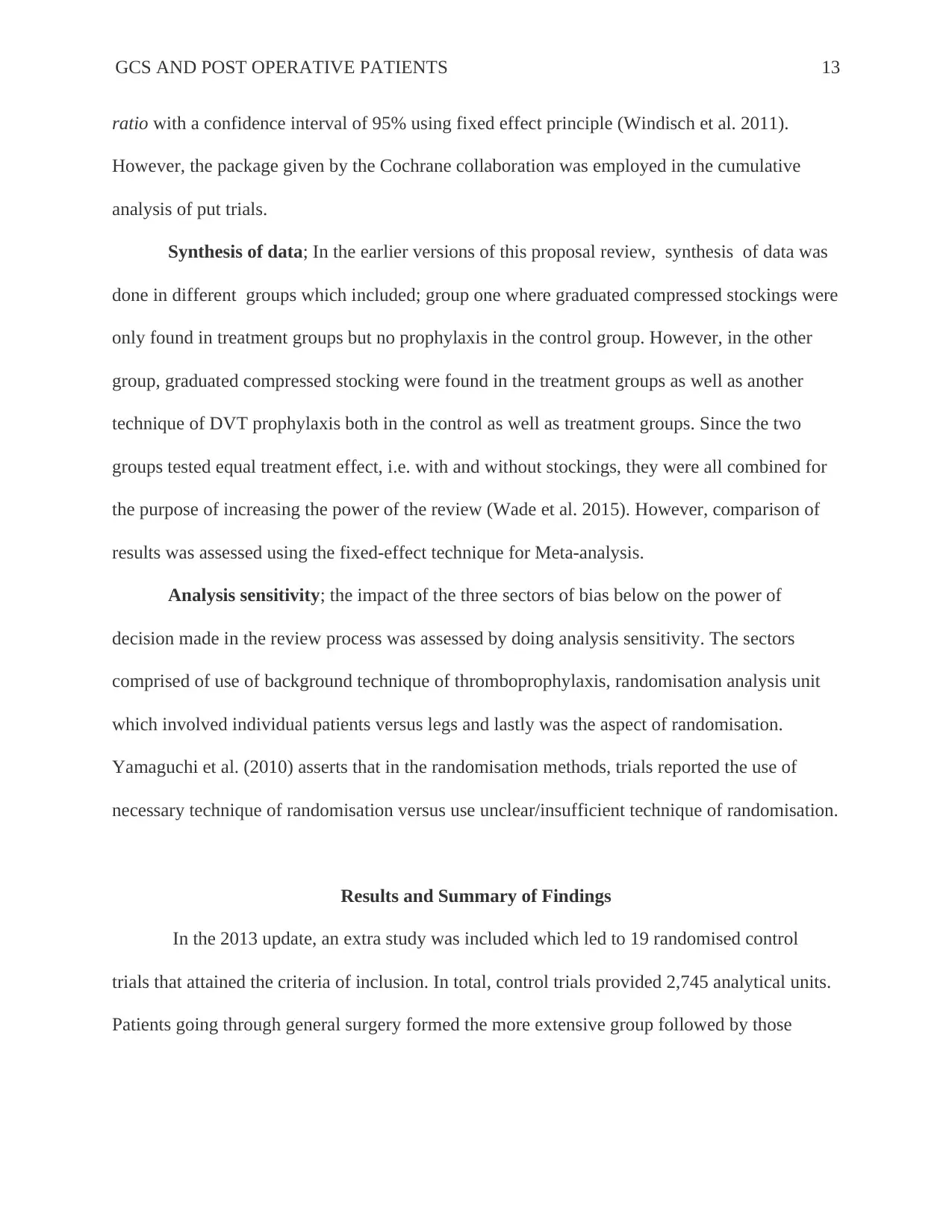
GCS AND POST OPERATIVE PATIENTS 13
ratio with a confidence interval of 95% using fixed effect principle (Windisch et al. 2011).
However, the package given by the Cochrane collaboration was employed in the cumulative
analysis of put trials.
Synthesis of data; In the earlier versions of this proposal review, synthesis of data was
done in different groups which included; group one where graduated compressed stockings were
only found in treatment groups but no prophylaxis in the control group. However, in the other
group, graduated compressed stocking were found in the treatment groups as well as another
technique of DVT prophylaxis both in the control as well as treatment groups. Since the two
groups tested equal treatment effect, i.e. with and without stockings, they were all combined for
the purpose of increasing the power of the review (Wade et al. 2015). However, comparison of
results was assessed using the fixed-effect technique for Meta-analysis.
Analysis sensitivity; the impact of the three sectors of bias below on the power of
decision made in the review process was assessed by doing analysis sensitivity. The sectors
comprised of use of background technique of thromboprophylaxis, randomisation analysis unit
which involved individual patients versus legs and lastly was the aspect of randomisation.
Yamaguchi et al. (2010) asserts that in the randomisation methods, trials reported the use of
necessary technique of randomisation versus use unclear/insufficient technique of randomisation.
Results and Summary of Findings
In the 2013 update, an extra study was included which led to 19 randomised control
trials that attained the criteria of inclusion. In total, control trials provided 2,745 analytical units.
Patients going through general surgery formed the more extensive group followed by those
ratio with a confidence interval of 95% using fixed effect principle (Windisch et al. 2011).
However, the package given by the Cochrane collaboration was employed in the cumulative
analysis of put trials.
Synthesis of data; In the earlier versions of this proposal review, synthesis of data was
done in different groups which included; group one where graduated compressed stockings were
only found in treatment groups but no prophylaxis in the control group. However, in the other
group, graduated compressed stocking were found in the treatment groups as well as another
technique of DVT prophylaxis both in the control as well as treatment groups. Since the two
groups tested equal treatment effect, i.e. with and without stockings, they were all combined for
the purpose of increasing the power of the review (Wade et al. 2015). However, comparison of
results was assessed using the fixed-effect technique for Meta-analysis.
Analysis sensitivity; the impact of the three sectors of bias below on the power of
decision made in the review process was assessed by doing analysis sensitivity. The sectors
comprised of use of background technique of thromboprophylaxis, randomisation analysis unit
which involved individual patients versus legs and lastly was the aspect of randomisation.
Yamaguchi et al. (2010) asserts that in the randomisation methods, trials reported the use of
necessary technique of randomisation versus use unclear/insufficient technique of randomisation.
Results and Summary of Findings
In the 2013 update, an extra study was included which led to 19 randomised control
trials that attained the criteria of inclusion. In total, control trials provided 2,745 analytical units.
Patients going through general surgery formed the more extensive group followed by those
Paraphrase This Document
Need a fresh take? Get an instant paraphrase of this document with our AI Paraphraser
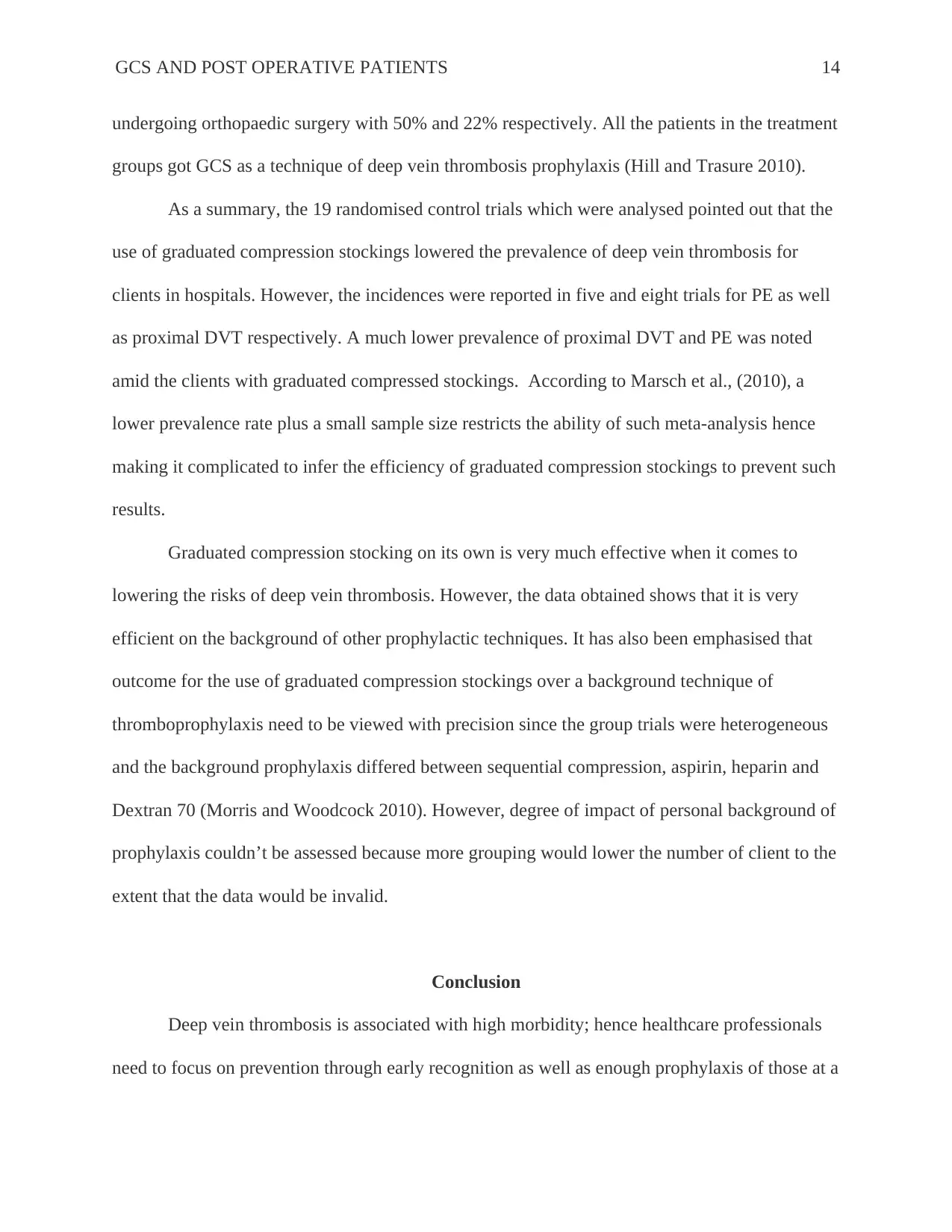
GCS AND POST OPERATIVE PATIENTS 14
undergoing orthopaedic surgery with 50% and 22% respectively. All the patients in the treatment
groups got GCS as a technique of deep vein thrombosis prophylaxis (Hill and Trasure 2010).
As a summary, the 19 randomised control trials which were analysed pointed out that the
use of graduated compression stockings lowered the prevalence of deep vein thrombosis for
clients in hospitals. However, the incidences were reported in five and eight trials for PE as well
as proximal DVT respectively. A much lower prevalence of proximal DVT and PE was noted
amid the clients with graduated compressed stockings. According to Marsch et al., (2010), a
lower prevalence rate plus a small sample size restricts the ability of such meta-analysis hence
making it complicated to infer the efficiency of graduated compression stockings to prevent such
results.
Graduated compression stocking on its own is very much effective when it comes to
lowering the risks of deep vein thrombosis. However, the data obtained shows that it is very
efficient on the background of other prophylactic techniques. It has also been emphasised that
outcome for the use of graduated compression stockings over a background technique of
thromboprophylaxis need to be viewed with precision since the group trials were heterogeneous
and the background prophylaxis differed between sequential compression, aspirin, heparin and
Dextran 70 (Morris and Woodcock 2010). However, degree of impact of personal background of
prophylaxis couldn’t be assessed because more grouping would lower the number of client to the
extent that the data would be invalid.
Conclusion
Deep vein thrombosis is associated with high morbidity; hence healthcare professionals
need to focus on prevention through early recognition as well as enough prophylaxis of those at a
undergoing orthopaedic surgery with 50% and 22% respectively. All the patients in the treatment
groups got GCS as a technique of deep vein thrombosis prophylaxis (Hill and Trasure 2010).
As a summary, the 19 randomised control trials which were analysed pointed out that the
use of graduated compression stockings lowered the prevalence of deep vein thrombosis for
clients in hospitals. However, the incidences were reported in five and eight trials for PE as well
as proximal DVT respectively. A much lower prevalence of proximal DVT and PE was noted
amid the clients with graduated compressed stockings. According to Marsch et al., (2010), a
lower prevalence rate plus a small sample size restricts the ability of such meta-analysis hence
making it complicated to infer the efficiency of graduated compression stockings to prevent such
results.
Graduated compression stocking on its own is very much effective when it comes to
lowering the risks of deep vein thrombosis. However, the data obtained shows that it is very
efficient on the background of other prophylactic techniques. It has also been emphasised that
outcome for the use of graduated compression stockings over a background technique of
thromboprophylaxis need to be viewed with precision since the group trials were heterogeneous
and the background prophylaxis differed between sequential compression, aspirin, heparin and
Dextran 70 (Morris and Woodcock 2010). However, degree of impact of personal background of
prophylaxis couldn’t be assessed because more grouping would lower the number of client to the
extent that the data would be invalid.
Conclusion
Deep vein thrombosis is associated with high morbidity; hence healthcare professionals
need to focus on prevention through early recognition as well as enough prophylaxis of those at a
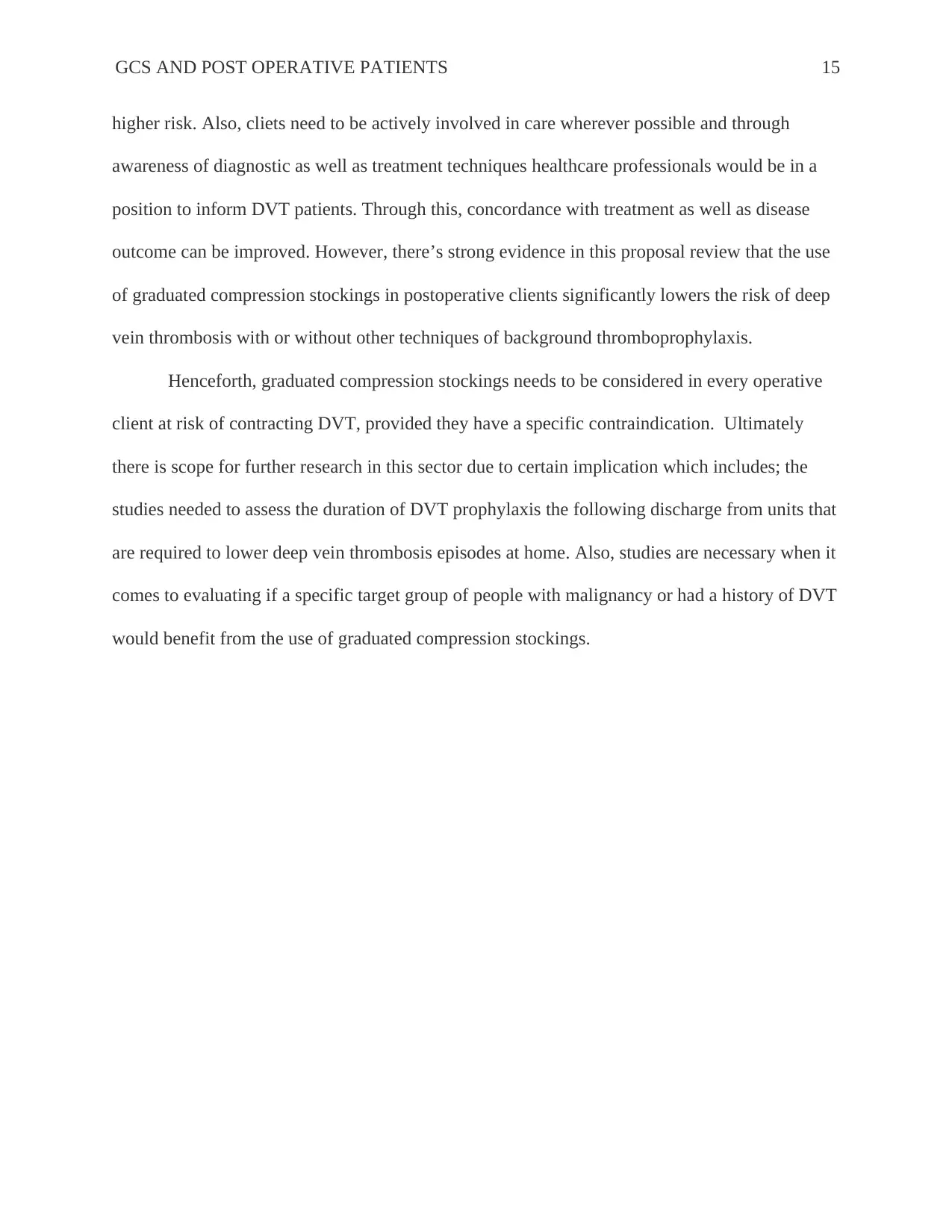
GCS AND POST OPERATIVE PATIENTS 15
higher risk. Also, cliets need to be actively involved in care wherever possible and through
awareness of diagnostic as well as treatment techniques healthcare professionals would be in a
position to inform DVT patients. Through this, concordance with treatment as well as disease
outcome can be improved. However, there’s strong evidence in this proposal review that the use
of graduated compression stockings in postoperative clients significantly lowers the risk of deep
vein thrombosis with or without other techniques of background thromboprophylaxis.
Henceforth, graduated compression stockings needs to be considered in every operative
client at risk of contracting DVT, provided they have a specific contraindication. Ultimately
there is scope for further research in this sector due to certain implication which includes; the
studies needed to assess the duration of DVT prophylaxis the following discharge from units that
are required to lower deep vein thrombosis episodes at home. Also, studies are necessary when it
comes to evaluating if a specific target group of people with malignancy or had a history of DVT
would benefit from the use of graduated compression stockings.
higher risk. Also, cliets need to be actively involved in care wherever possible and through
awareness of diagnostic as well as treatment techniques healthcare professionals would be in a
position to inform DVT patients. Through this, concordance with treatment as well as disease
outcome can be improved. However, there’s strong evidence in this proposal review that the use
of graduated compression stockings in postoperative clients significantly lowers the risk of deep
vein thrombosis with or without other techniques of background thromboprophylaxis.
Henceforth, graduated compression stockings needs to be considered in every operative
client at risk of contracting DVT, provided they have a specific contraindication. Ultimately
there is scope for further research in this sector due to certain implication which includes; the
studies needed to assess the duration of DVT prophylaxis the following discharge from units that
are required to lower deep vein thrombosis episodes at home. Also, studies are necessary when it
comes to evaluating if a specific target group of people with malignancy or had a history of DVT
would benefit from the use of graduated compression stockings.
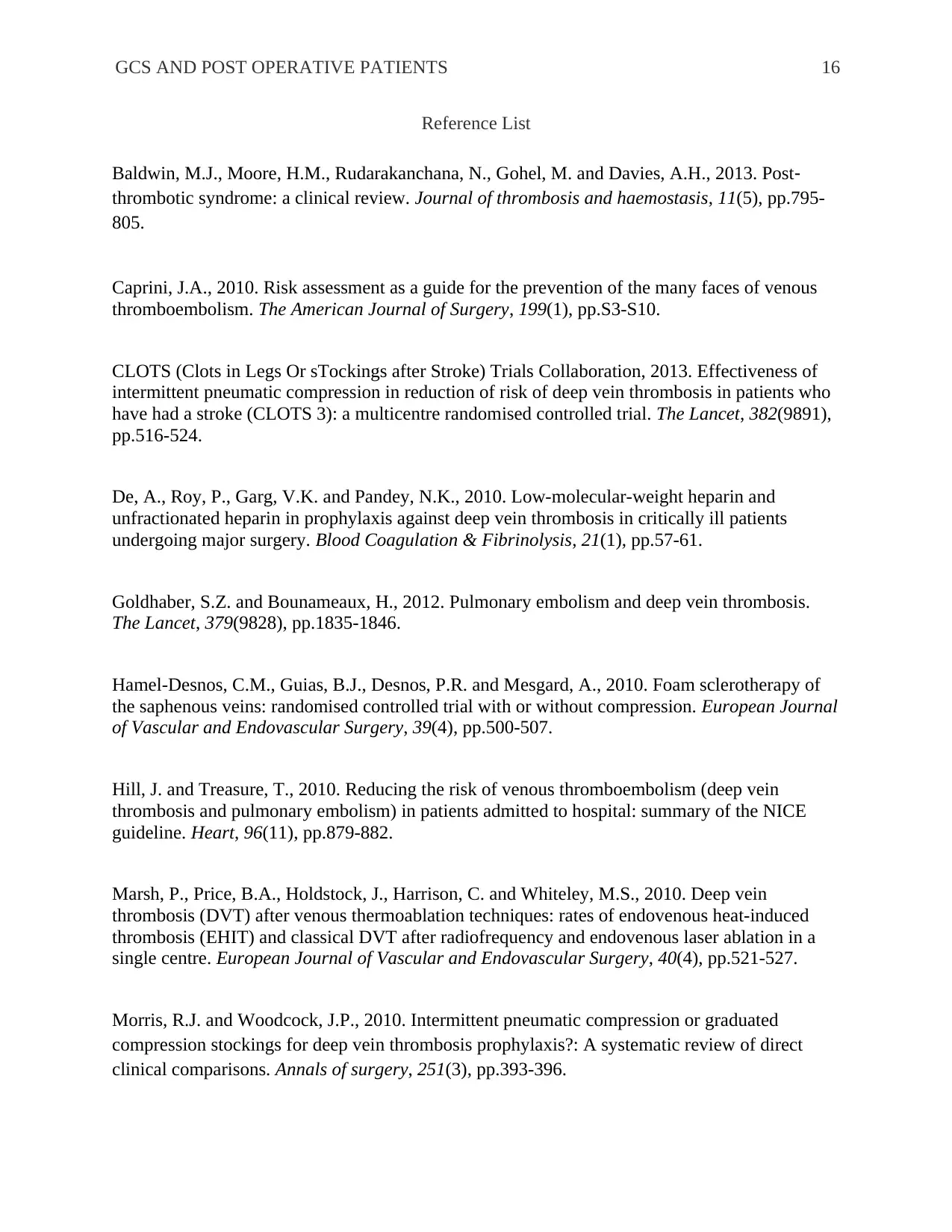
GCS AND POST OPERATIVE PATIENTS 16
Reference List
Baldwin, M.J., Moore, H.M., Rudarakanchana, N., Gohel, M. and Davies, A.H., 2013. Post‐
thrombotic syndrome: a clinical review. Journal of thrombosis and haemostasis, 11(5), pp.795-
805.
Caprini, J.A., 2010. Risk assessment as a guide for the prevention of the many faces of venous
thromboembolism. The American Journal of Surgery, 199(1), pp.S3-S10.
CLOTS (Clots in Legs Or sTockings after Stroke) Trials Collaboration, 2013. Effectiveness of
intermittent pneumatic compression in reduction of risk of deep vein thrombosis in patients who
have had a stroke (CLOTS 3): a multicentre randomised controlled trial. The Lancet, 382(9891),
pp.516-524.
De, A., Roy, P., Garg, V.K. and Pandey, N.K., 2010. Low-molecular-weight heparin and
unfractionated heparin in prophylaxis against deep vein thrombosis in critically ill patients
undergoing major surgery. Blood Coagulation & Fibrinolysis, 21(1), pp.57-61.
Goldhaber, S.Z. and Bounameaux, H., 2012. Pulmonary embolism and deep vein thrombosis.
The Lancet, 379(9828), pp.1835-1846.
Hamel-Desnos, C.M., Guias, B.J., Desnos, P.R. and Mesgard, A., 2010. Foam sclerotherapy of
the saphenous veins: randomised controlled trial with or without compression. European Journal
of Vascular and Endovascular Surgery, 39(4), pp.500-507.
Hill, J. and Treasure, T., 2010. Reducing the risk of venous thromboembolism (deep vein
thrombosis and pulmonary embolism) in patients admitted to hospital: summary of the NICE
guideline. Heart, 96(11), pp.879-882.
Marsh, P., Price, B.A., Holdstock, J., Harrison, C. and Whiteley, M.S., 2010. Deep vein
thrombosis (DVT) after venous thermoablation techniques: rates of endovenous heat-induced
thrombosis (EHIT) and classical DVT after radiofrequency and endovenous laser ablation in a
single centre. European Journal of Vascular and Endovascular Surgery, 40(4), pp.521-527.
Morris, R.J. and Woodcock, J.P., 2010. Intermittent pneumatic compression or graduated
compression stockings for deep vein thrombosis prophylaxis?: A systematic review of direct
clinical comparisons. Annals of surgery, 251(3), pp.393-396.
Reference List
Baldwin, M.J., Moore, H.M., Rudarakanchana, N., Gohel, M. and Davies, A.H., 2013. Post‐
thrombotic syndrome: a clinical review. Journal of thrombosis and haemostasis, 11(5), pp.795-
805.
Caprini, J.A., 2010. Risk assessment as a guide for the prevention of the many faces of venous
thromboembolism. The American Journal of Surgery, 199(1), pp.S3-S10.
CLOTS (Clots in Legs Or sTockings after Stroke) Trials Collaboration, 2013. Effectiveness of
intermittent pneumatic compression in reduction of risk of deep vein thrombosis in patients who
have had a stroke (CLOTS 3): a multicentre randomised controlled trial. The Lancet, 382(9891),
pp.516-524.
De, A., Roy, P., Garg, V.K. and Pandey, N.K., 2010. Low-molecular-weight heparin and
unfractionated heparin in prophylaxis against deep vein thrombosis in critically ill patients
undergoing major surgery. Blood Coagulation & Fibrinolysis, 21(1), pp.57-61.
Goldhaber, S.Z. and Bounameaux, H., 2012. Pulmonary embolism and deep vein thrombosis.
The Lancet, 379(9828), pp.1835-1846.
Hamel-Desnos, C.M., Guias, B.J., Desnos, P.R. and Mesgard, A., 2010. Foam sclerotherapy of
the saphenous veins: randomised controlled trial with or without compression. European Journal
of Vascular and Endovascular Surgery, 39(4), pp.500-507.
Hill, J. and Treasure, T., 2010. Reducing the risk of venous thromboembolism (deep vein
thrombosis and pulmonary embolism) in patients admitted to hospital: summary of the NICE
guideline. Heart, 96(11), pp.879-882.
Marsh, P., Price, B.A., Holdstock, J., Harrison, C. and Whiteley, M.S., 2010. Deep vein
thrombosis (DVT) after venous thermoablation techniques: rates of endovenous heat-induced
thrombosis (EHIT) and classical DVT after radiofrequency and endovenous laser ablation in a
single centre. European Journal of Vascular and Endovascular Surgery, 40(4), pp.521-527.
Morris, R.J. and Woodcock, J.P., 2010. Intermittent pneumatic compression or graduated
compression stockings for deep vein thrombosis prophylaxis?: A systematic review of direct
clinical comparisons. Annals of surgery, 251(3), pp.393-396.
Secure Best Marks with AI Grader
Need help grading? Try our AI Grader for instant feedback on your assignments.
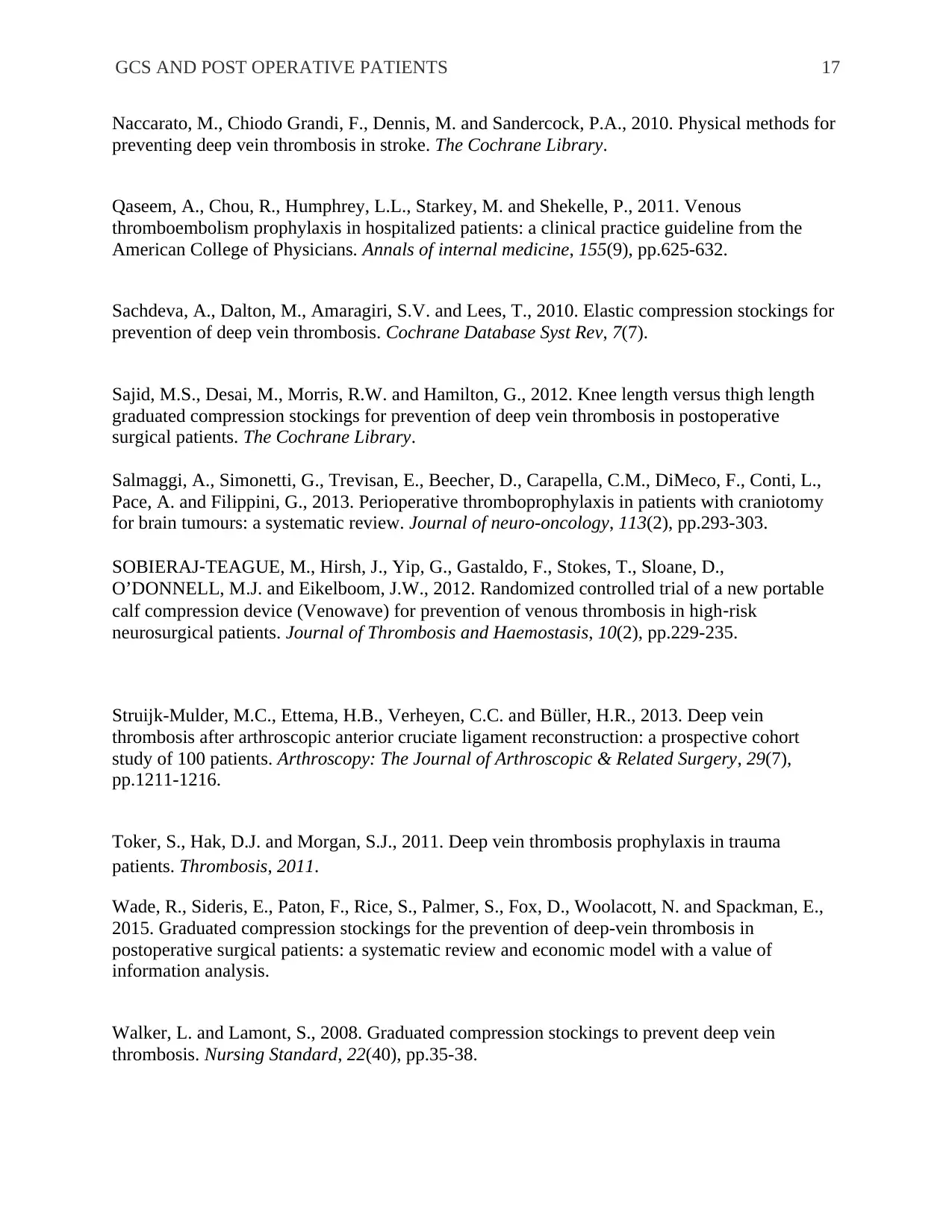
GCS AND POST OPERATIVE PATIENTS 17
Naccarato, M., Chiodo Grandi, F., Dennis, M. and Sandercock, P.A., 2010. Physical methods for
preventing deep vein thrombosis in stroke. The Cochrane Library.
Qaseem, A., Chou, R., Humphrey, L.L., Starkey, M. and Shekelle, P., 2011. Venous
thromboembolism prophylaxis in hospitalized patients: a clinical practice guideline from the
American College of Physicians. Annals of internal medicine, 155(9), pp.625-632.
Sachdeva, A., Dalton, M., Amaragiri, S.V. and Lees, T., 2010. Elastic compression stockings for
prevention of deep vein thrombosis. Cochrane Database Syst Rev, 7(7).
Sajid, M.S., Desai, M., Morris, R.W. and Hamilton, G., 2012. Knee length versus thigh length
graduated compression stockings for prevention of deep vein thrombosis in postoperative
surgical patients. The Cochrane Library.
Salmaggi, A., Simonetti, G., Trevisan, E., Beecher, D., Carapella, C.M., DiMeco, F., Conti, L.,
Pace, A. and Filippini, G., 2013. Perioperative thromboprophylaxis in patients with craniotomy
for brain tumours: a systematic review. Journal of neuro-oncology, 113(2), pp.293-303.
SOBIERAJ‐TEAGUE, M., Hirsh, J., Yip, G., Gastaldo, F., Stokes, T., Sloane, D.,
O’DONNELL, M.J. and Eikelboom, J.W., 2012. Randomized controlled trial of a new portable
calf compression device (Venowave) for prevention of venous thrombosis in high‐risk
neurosurgical patients. Journal of Thrombosis and Haemostasis, 10(2), pp.229-235.
Struijk-Mulder, M.C., Ettema, H.B., Verheyen, C.C. and Büller, H.R., 2013. Deep vein
thrombosis after arthroscopic anterior cruciate ligament reconstruction: a prospective cohort
study of 100 patients. Arthroscopy: The Journal of Arthroscopic & Related Surgery, 29(7),
pp.1211-1216.
Toker, S., Hak, D.J. and Morgan, S.J., 2011. Deep vein thrombosis prophylaxis in trauma
patients. Thrombosis, 2011.
Wade, R., Sideris, E., Paton, F., Rice, S., Palmer, S., Fox, D., Woolacott, N. and Spackman, E.,
2015. Graduated compression stockings for the prevention of deep-vein thrombosis in
postoperative surgical patients: a systematic review and economic model with a value of
information analysis.
Walker, L. and Lamont, S., 2008. Graduated compression stockings to prevent deep vein
thrombosis. Nursing Standard, 22(40), pp.35-38.
Naccarato, M., Chiodo Grandi, F., Dennis, M. and Sandercock, P.A., 2010. Physical methods for
preventing deep vein thrombosis in stroke. The Cochrane Library.
Qaseem, A., Chou, R., Humphrey, L.L., Starkey, M. and Shekelle, P., 2011. Venous
thromboembolism prophylaxis in hospitalized patients: a clinical practice guideline from the
American College of Physicians. Annals of internal medicine, 155(9), pp.625-632.
Sachdeva, A., Dalton, M., Amaragiri, S.V. and Lees, T., 2010. Elastic compression stockings for
prevention of deep vein thrombosis. Cochrane Database Syst Rev, 7(7).
Sajid, M.S., Desai, M., Morris, R.W. and Hamilton, G., 2012. Knee length versus thigh length
graduated compression stockings for prevention of deep vein thrombosis in postoperative
surgical patients. The Cochrane Library.
Salmaggi, A., Simonetti, G., Trevisan, E., Beecher, D., Carapella, C.M., DiMeco, F., Conti, L.,
Pace, A. and Filippini, G., 2013. Perioperative thromboprophylaxis in patients with craniotomy
for brain tumours: a systematic review. Journal of neuro-oncology, 113(2), pp.293-303.
SOBIERAJ‐TEAGUE, M., Hirsh, J., Yip, G., Gastaldo, F., Stokes, T., Sloane, D.,
O’DONNELL, M.J. and Eikelboom, J.W., 2012. Randomized controlled trial of a new portable
calf compression device (Venowave) for prevention of venous thrombosis in high‐risk
neurosurgical patients. Journal of Thrombosis and Haemostasis, 10(2), pp.229-235.
Struijk-Mulder, M.C., Ettema, H.B., Verheyen, C.C. and Büller, H.R., 2013. Deep vein
thrombosis after arthroscopic anterior cruciate ligament reconstruction: a prospective cohort
study of 100 patients. Arthroscopy: The Journal of Arthroscopic & Related Surgery, 29(7),
pp.1211-1216.
Toker, S., Hak, D.J. and Morgan, S.J., 2011. Deep vein thrombosis prophylaxis in trauma
patients. Thrombosis, 2011.
Wade, R., Sideris, E., Paton, F., Rice, S., Palmer, S., Fox, D., Woolacott, N. and Spackman, E.,
2015. Graduated compression stockings for the prevention of deep-vein thrombosis in
postoperative surgical patients: a systematic review and economic model with a value of
information analysis.
Walker, L. and Lamont, S., 2008. Graduated compression stockings to prevent deep vein
thrombosis. Nursing Standard, 22(40), pp.35-38.

GCS AND POST OPERATIVE PATIENTS 18
Windisch, C., Kolb, W., Kolb, K., Grützner, P., Venbrocks, R. and Anders, J., 2011. Pneumatic
compression with foot pumps facilitates early postoperative mobilisation in total knee
arthroplasty. International orthopaedics, 35(7), pp.995-1000.
Yamaguchi, T., Hasegawa, M., Niimi, R. and Sudo, A., 2010. Incidence and time course of
asymptomatic deep vein thrombosis with fondaparinux in patients undergoing total joint
arthroplasty. Thrombosis research, 126(4), pp.e323-e326.
Windisch, C., Kolb, W., Kolb, K., Grützner, P., Venbrocks, R. and Anders, J., 2011. Pneumatic
compression with foot pumps facilitates early postoperative mobilisation in total knee
arthroplasty. International orthopaedics, 35(7), pp.995-1000.
Yamaguchi, T., Hasegawa, M., Niimi, R. and Sudo, A., 2010. Incidence and time course of
asymptomatic deep vein thrombosis with fondaparinux in patients undergoing total joint
arthroplasty. Thrombosis research, 126(4), pp.e323-e326.
1 out of 18
Related Documents
Your All-in-One AI-Powered Toolkit for Academic Success.
+13062052269
info@desklib.com
Available 24*7 on WhatsApp / Email
![[object Object]](/_next/static/media/star-bottom.7253800d.svg)
Unlock your academic potential
© 2024 | Zucol Services PVT LTD | All rights reserved.





